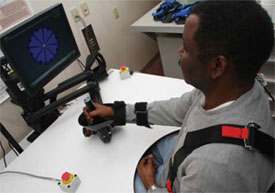Thursday, May 6, 2010
In robotics study, gains seen even years after stroke
May 5, 2010
A VA study that used robots to deliver high-intensity therapy has provided strong new evidence that people can gain back function even years after a stroke. The study appeared online April 16 in the New England Journal of Medicine.
"There are nearly six million stroke patients in the U.S. with chronic deficits. We've shown that with the right therapy, they can see improvements in movement, everyday function and quality of life," said study chairman Albert Lo, MD, PhD, a neurologist at the Providence (R.I.) VA Medical Center.
The three-year study enrolled 127 Veterans at four VA sites. All had suffered a stroke at least six months earlier and had moderate to severe impairment of an arm. In most cases, the strokes had occurred several years beforehand—even as far back as 1980, in one case. Patients typically get rehabilitation therapy only during the first six months or so after a stroke. Conventional thinking has been that further therapy offers little benefit. Studies in recent years, though, have begun to suggest otherwise.
Improvements seen in everyday function
The therapy in the VA study was repetitive, guided movement, three times a week for three months. One group of patients did the therapy with the use of robots designed at the Massachusetts Institute of Technology. Others did similar high-intensity exercises with a therapist. A third, smaller group had only "usual care"—they received general health care but no specific therapy for their stroke-damaged limb.
The two therapy groups showed improvements in arm movement and strength, everyday function, and quality of life. The gains began slowly during the initial three-month therapy period and continued to grow over the next six months, even after therapy had ended. At nine-month followups, the gains for the two therapy groups were still modest but were statistically and clinically significant, says Lo.
To measure the impact on everyday life, researchers asked patients a battery of questions: for example, how well they could cut food with a fork and knife, open jars or tie their shoes. The patients were also asked about activities not directly related to their arm, such as walking or stair-climbing. Most patients in the two therapy groups reported across-the-board progress, compared with no progress in the usual-care group.
Lo's team theorizes that boosting arm function helped patients be more active overall, which led to wider health improvements. "We believe that by getting better control of their arm, they were able to achieve more balance and mobility in general," he said.
Usual-care patients were offered the intensive therapy after the study ended, so they too could benefit from it. The VA study featured a robot called the MIT-Manus, which had been tested in a few smaller trials. Users sit at a table with their weakened arm attached to the device. They follow prompts on the screen—or instructions from a therapist—and try to perform a task with their arm. The robot senses their movement and helps as needed.
"These are video-game-like tasks," said George Wittenberg, MD, PhD, the study's lead investigator in Baltimore. "The patients are moving a cursor from one place to another, or guiding a symbol on the screen through a maze, and using their arms to control the movement of the cursor. The robots provide 'power steering' for the arms—just enough assistance to allow people to move." He said the therapy takes advantage of neuroplasticity—the ability of the adult brain to "rewire" itself. When neurons die because of a stroke, other brain cells, prompted by assisted body movements, begin compensating for the lost function. The robotic therapy mimics hand-over-hand therapy, in which the therapist asks the patient to move his affected hand and then helps as needed. "The difference has to do with the intensity and the duration of therapy that's possible with the robot," noted Wittenberg. During each hour-long therapy session, patients in the study made hundreds of repetitive motions with their impaired arm.
Lo stressed that robotic therapy still requires supervision from therapists. "This study was not about robots versus therapists," he said. "It was about therapists using robots or conventional methods. The therapist will never be out of the picture."
Subscribe to:
Post Comments (Atom)







No comments:
Post a Comment